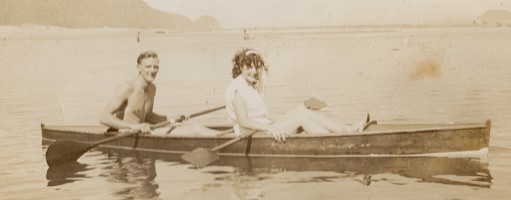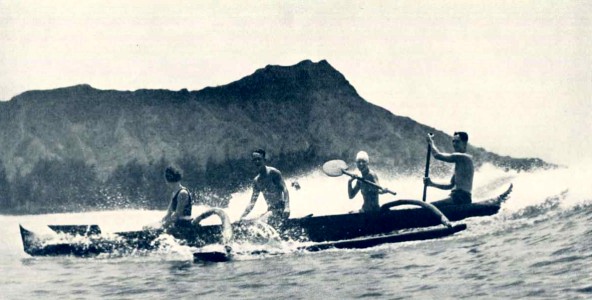surfresearch.com.au
 |
surfresearch.com.au
history : tom blake 1935
|
TOM
BLAKE
AND THE HOLLOW BOARD
1926 - 1935




Eight-oared
shell
(modern rowing boat)
Dating back
to 1855 when this keelless eight-oared racing boat made its
appearance at Henley on Thames.
Designed by
Matthew Taylor, for the Royal Rowing Club, it was built,
with an outer skin of bent or moulded cedar wood, bottom
side upwards on the moulds.
Ribs were
fitted inside the skin after the boat had been reversed.
Oxford
University launched a similar craft of their own, at Putney
in 1857, 63 feet in length and 25 inches in beam.
Over the
years the dimensions and fittings varied but these were
prototypes for most racing boats into the 20th century and
is used in the University Boat Race crewed by a coxed eight.
Hulls were
made of cedar wood imported from Central America which
although only three sixteenths of an inch thick could
withstand pressures of 8,000 pounds below the waterline.
During the
1970s experiments were made with fibreglass, and other
materials, which has led to the modern rowing eight and the
four which now dominate the sport..
http://easyweb.easynet.co.uk/jim.shead/Boats4.html
The Hollow Paddle
Board, a timber frame with plywood skin, was developed by Tom
Blake in Hawaii.
Around 1926, Tom
Blake attempted to recreate some of the larger ancient Hawaiian
solid wood Olo designs that he had restored for the Bishop
Museum, Honolulu.
"Strange as
it may seem, three old-style Hawaiian surfboards of huge
dimensions and weight have hung on the walls of the Bishop
Museum in Honolulu for twenty years or more without anyone
doing more than wonder how in the world these great boards
were used, as they were too heavy and long to be
practicable."
Blake,
page 59.
 Chief
Paki's
Olo 15ft 7'' circa 1830 #502
Chief
Paki's
Olo 15ft 7'' circa 1830 #502
Held by the
Bishop Museum, Honolulu, Catalogue No. 298
Image : Margan
and
Finney, page 23
"I
too wondered about these boards in the museum, wondered so
much that in 1926 I built a duplicate of them as an
experiment, my object being to find not a better board, but
to find a faster board to use in the annual and popular
surfboard paddling races held in California each summer."
Blake,
page 59
This board
successfully performed to Blake's expectactions, however the
extreme weight was a major difficulty. His first experiment,
hollowing out a solid board, had been attempted previously -
"As
early as as 1918 Claude West had experimented to make a
hollow board, chippig and gouging out a solid redwood slab
and fitting a small sealed and screwed deck.
The
experiment was not a success; plywoods were not yet, nor
plastic glues, timbers were sun dried intead of kiln dried
as now, and sun-cracks quickly gaped to let in water.
'Snowy'
McAllister of Manly...also experimented with chipped out
boards.
He, too,
was unsuccessful, though he improved on the West model,
also steamling the tail in the hope of gaining more
speed."
Maxwell
, pages 239-240.
Probably
similar attempts at hollowing boards had been made by other
surfers before Tom Blake...
however a
combination of drilled holes and extended curing made a
noticable difference in weight
"This
surfboard was sixteen feet long and weight 120 pounds."
Blake,
page 59
Blake also
reported the length of this board as 14 ft 6 inches in 1935,
see below.
 "hollow
-
length, 14 1/2 feet; width 20 inches; weight 120 pounds"
"hollow
-
length, 14 1/2 feet; width 20 inches; weight 120 pounds"
Tom Blake's
First Experimental Hollow 1926 -1928 14 ft. 6 inches
Image cropped
from a photograph by Thomas Edward Blake, 1930
"Waves
and Thrills at Waikiki "
National
Geograghic Magazine May 1935 Volume 47 Number 5
page 597
Nat
Young
personally interviewed Tom Blake for his recollections of this
period, published in 1983's The
History of Surfing, and although the length varies
from Blake's 1935 notes, the account is detailed...
" He
purchased a solid slab of redwood 16' long, 2' wide and 4"
thick.
It
weighed around 150 pounds - too heavy to be of service as
a surfboard, even when shaped.
So to
lighten it he drilled hundreds of holes in it from top to
bottom, each hole removing a cylinder of wood four inches
long.
Then he
left the holey board season for a month.
After the
wood had fully dried he covered the top and bottom
surfaces with a thin layer of wood, sealing the holes. I
t
finished up 15' long, 19" wide and 4" thick, looking like
a cigar.
It's
weight was only 100 lbs, because it was partly hollow."
Nat
History page 49
The second
edition of History of Surfing (1994) is dedicated to
Tom Blake who died May 5, 1994, aged 92.
The complete
photograph, see below,
notes a third length for this board of 14 ft 6 inches.
There is some
confusion as to these board's actual lengths.
It is possible
that the board's length was reduced between 1926 and 1930, due
to modifications or repairs - it certainly reduced in weight..
The board's
paddling performance was demonstrated in 1928 when, after a
slow start, Tom Blake emphatically won the 880 yards paddling
race at the Pacific Coast Surfing Contest, Balboa, California.
Blake,
page 59
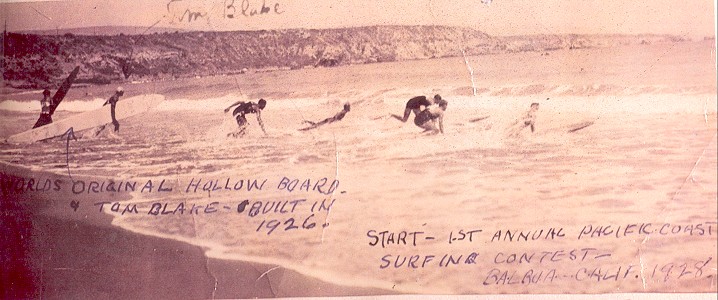
" WORLD'S
ORIGINAL HOLLOW BOARD.
TOM BLAKE
- BUILT IN 1926
START -
1ST ANNUAL PACIFIC COAST SURFING CONTEST - BALBOA
CALIF. 1928
The
long white board above was the first reproduction of the
ancient Hawaiian OLO chiefs board, however it was hollow
to lighten it. Duke Kahanamoku also rode this board. Thos.
Blake"
Uncredited photograph and hand written notes
by Tom Blake from a copy of Hawaiian Surfboard, 1935.
Hawaiian
Historical Society.
reproduced in Lueras,
page 83.
Encouraged by his
initial experiments, Tom Blake's second proto-type was a major
advance...
"In the
later part of 1929, after three years of experimenting, I
introduced at Waikiki a new type of surfboard;...but
in reality the design was taken from the ancient Hawaiian
type of board, also from the English racing shell."
Blake,
page 51
The
construction of this board is unclear, in Blake's notes does "English
racing shell " refer to the template, the ribbed
construction or both?
It may have
used...
- the drilled
hole technique
- laminated
with chambered strips, or
- built form a
timber frame and covered with a layer of the newly developed
marine grade ply- wood, in the manner of racing shells or
canoes of the period.
or some
combination of these methods.
Given the
reported weight of only 60 pounds, one of the latter methods
seems most likely.
The template
of this board was radically streamlined compared to it's
predecessor.
The
application of a light skin over a ridgid frame for boats
dates back to the Irish chonicle or the Innuit kayak.
"It was
called a 'cigar board', because a newspaper reporter
thought it was shaped like a giant cigar. This board was
really graceful and beautiful to look at, and in
performance so so ggod that officials of the Annual
surfboard Paddling Championship immediately..."
Blake,
pages 51 - 52.
 "a
light,
hollow 16 footer, broke all paddle-race records at Waikiki."
"a
light,
hollow 16 footer, broke all paddle-race records at Waikiki."
Tom
Blake's Hollow Paddle board, 16 ft 60 pounds1929
Image cropped
from a photograph by Thomas Edward Blake, 1930
"Waves
and Thrills at Waikiki "
National
Geograghic Magazine
May 1935 Volume
47 Number 5 page 597
A third hollow
board followed...
"The riding
model, 'Okohola', came a month later (after a
paddling competition), December 1929.."
Blake,
page 59
" ... a
riding board sixteen feet long. The new riding board was a
great success and Duke Kahanamoku built his great 16 -
foot hollow redwood board along about the same time. He is
an excellent craftsman and shapes the lines and balance of
his boards with the eye; he detects its irregularities by
touch of the hand."
Blake,
page 52
 "a
reproduction
of the ancient Hawaiian rider."
"a
reproduction
of the ancient Hawaiian rider."
Tom
Blake Hollow Wave riding board 15 ft December 1929
Image cropped
from a photograph by Thomas Edward Blake, 1930
"Waves
and Thrills at Waikiki "
National
Geograghic Magazine May 1935 Volume 47 Number 5
page 597
This success of
the design, primarily as a paddle board, was followed by
the common hollow design of plywood covering over a light
wood frame, with a bung.
He rapidly
incorporated current aircraft and boat building techniques
into surfboard design and his design of a light timber frame
covered with plywood panels resulted in a huge weight
reduction.
On 18th April,
1931 Thomas Edward Blake submitted three pages with a
detailed drawing for a ' Water Sled'. and was subsequently
granted US Patent No. 1,872,230 by the US Patents and
Trademarks Office, Washington DC.
Initially
viewed with scepticism, the paddling advantages were
emphatically demonstrated as Tom Blake dominated paddle races
in California and Hawaii in the 1930’s.
Aware of the
life saving potential of such a craft and an enthusiastic
promoter of his sport, Tom Blake gave his design international
exposure by publishing the blueprints and construction
details, principally in various Popular Mechanics Magazines of
the period. See below, or Plans
and Specifications.

From: Tom
Blake
: Riding the Breakers on this Hollow Hawaiian Surfboard
-
Popular
Mechanics Magazine
July 1937
Volume 68 Number 1
pages 114 - 117
Publication
saw the design rapidly adopted around the world, notably
Australia, New Zealand, Peru and South Africa.
In these
countries it had an extended life due to the lag before these
countries caught up with the developments in fibreglass and
foam.
In Australia the
design first appearred as the Racing 16 and was later modified
to a finned Malibu or Okinuee (1956-1958) while in New Zealand
the lag was even longer and hollow Malibu boards were
manufactured up to 1961.
Maxwell
pages 240-24.
Circa 1934 Tom
Blake added a small water ski type fin/skeg to one of his
hollow boards.
Although an
significant addition, because of the emphasis on paddling, the
small size relative to the board, the increased danger and the
difficulty in attachment, many riders do not consider fins as
a necessity.
It rarely
appears on Australian examples of long Hollows.
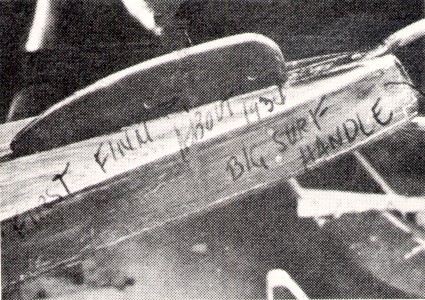
Tom Blake's
first fin with Big Surf Handle
Photograph and
hand written caption by Tom Blake.
Surfer
Magazine,
March 1981,
Volume 22, Number 3, page 37.
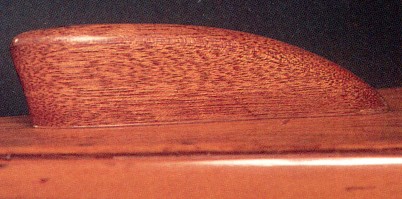 |
circa 1935
Nub
Fin/ Keel
Tom Blake
solid
timber
2 x 12
b @ 6? inches (Approximation)
Photograph:
Bjorn DeBoer :
LONGBOARD
Magazine
Vol 4
No 5. 1996
November/December
page 68
|
In
the
area of design, although many surfers maintained an allegiance
to the solid wood alaia, the pioneering of large
surf at Makaha and on the North Shore saw the development in
1937 of the Hot Curl.
A solid wood
no-fin gun-template board with deep V bottom at the tail was
built by John Kelly, Wally Froiseth and Fran Heath in Hawaii.
Robert Mitchell Company
Gary Lynch noted (March 2019) that the Robert
Mitchell Company built Tom Blake’s paddle and surfboards.
Their production line was slow but extremely high quality
regarding their woodwork:
Robert Mitchell was an Irish immigrant who partnered with
Frederick Rammelsberg to open a furniture-making business in
Cincinnati in the 1830s or ’40s.
Mitchell & Rammelsberg incorporated in 1867.
In 1881, after Rammelsberg had died, the corporate name was
changed to Robert Mitchell Furniture Co.
It remained in business until about 1940.
Any Victorian-era furniture made by Mitchell & Rammelsberg
or Robert Mitchell Furniture Co. is high-quality and prized by
collectors.
https://www.kovels.com/collectors-questions/robert-mitchell-dresser-chest.html
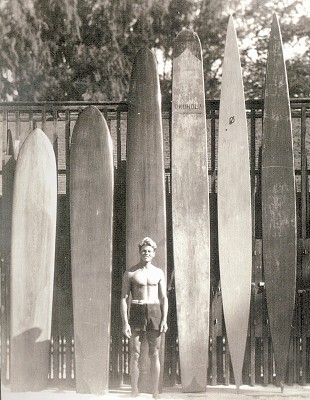
"THE
PHOTOGRAPHER DISPLAYS SOME SURFBOARDS, ALL BUILT BY
HIMSELF
He stands
before his redwood favourite, 11 feet long, 23 inches
wide, and 31/4 inches thick, square-edged on the bottom
for steadiness.
Number 2,
of red cedar and a foot longer, is for fast paddling.
For big
waves, the third, hollow - length, 14 1/2 feet; width 20
inches; weight 120 pounds - has proved easier to handle
than the fourth, a reproduction of the ancient Hawaiian
rider.
The
fifth, a light, hollow 16 footer, broke all paddle-race
records at Waikiki.
The last,
solid and heavy, is a training board."
Boards and self portrait by Thomas Edward
Blake 1930.
Photograph and
notation published in
"Waves
and Thrills at Waikiki "
National
Geograghic Magazine May 1935 Volume 47 Number 5
page 597
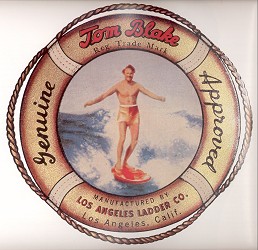
Notes :
1. This portrait
introduced a portfolio of seven duo-tone surfing photographs
with notes, that were also reproduced in Tom Blake's The
Hawaiian Surfboard, 1935.
However,
these are in blue duotone, especially selected by Blake
for this printing.
2. The
photographs, taken from Blake's board in his home made
water-proof housing, were a major inspiration to other surf
photographers, notably Don
James and 'Doc'
Ball.
3. The last
photograph of the portfolio is of outrigger canoe surfing - one
of the passengers is aviatrix, Amelia Earhart.
4. The photgraph
was taken in the grounds of the Outrigger Canoe Club, Blake's
boards are leaning against the member's surfboard lockers.
5. This is the
first known quiver portrait.
6. The
image was not included in The Hawaiian Surfboard,
1935
7. Another
photgraph from the same shoot, with Blake in the centre of the
boards, is the more commonly reproduced version.
8. None of the
hollow boards show evidence of a draining plug.
This is an almost
universal feature of hollow surfboards from about 1940 to the
present.
Structually, if
the board is hollow it should have a drain or pressure plug to
let out any water from dings and to equalise the pressure for
climatic extremes.
The Runestone Museum, 206 Broadway,
Alexandria, (320) 763-3160, www.runestonemuseum.org.
Admission $5.
Closed Sunday mid-October to mid-May. Admission includes the
Minnesota Lakes Maritime Museum next door, which includes a
40-foot replica of a Viking ship; dozens of vintage "Lady of the
Lakes," ribbed-hull wooden fishing boats; and what the museum
says is the first surfboard patented in the United States, by a
local man named Erick G. Erickson, in 1929.
http://www.chris-craft.org/discussion : early
aquaplane info needed
thompsonboatboy
Posted:
Mon Feb 11, 2008 3:21 pm
I just grabbed
the 1934 brochure from Thompson Bros. Boat Mfg. Co.
They had two
aquaplanes pictured.
One is the
"Hawaiian Surf Board" which is redwood 3/4 inch planks.
The other is
the "Hawaiian Floater."
The latter is
a hollow, built-up board.
It had a
slight V shaped bottom, 6 feet long and 28 inches wide.
I have the
Hawaiian Surf Board, with a great Thompson logo on it.
Both are
painted bright red and varnished.
List price
in the '34 brochure, $8.00 for the Surf Board and $12.00 for
the Floater!
The Argus (Junior) Thursday 3 December
1936 page?
Make Your
Own (Surfboard)
Two models - Free
and Tow (Aquaplane with fin).
Victoria
and Albert Museum : Plywood, 2016.
www.vam.ac.uk/exhibitions/plywood-material-of-the-modern-world
Noted by Alex William, The
Surf Blurb, 17-07-2017
The
Victoria and Albert Museum in London has a few Plywood
surfboards on show as part of the History of Plywood.
The exhibition is called Plywood: Material of the
Modern World and will last from July 15 to
November 12, 2017.-
Free entry
The 11ft, 7 1/2
inches toothpick pictured below is
one of several boards supplied by MOBS and
myself.
My Toothpick dates from 1940/45.
It has been bought back from Australia just after WWII
to Mylor in Cornwall by Reginald Gordon Rollason.
On
4/08/2016 2:27 AM, Elizabeth Bisley wrote:
Dear Geoff,
I am a curator at the Victoria and Albert
Museum in London, and am working on an exhibition about the
history of plywood. I am very interested in plywood surfboards,
examples of which we plan to show in the exhibition. I have seen
Tom Blake described in various places as the first designer to
use plywood in his boards, but haven’t been able to find any
definite evidence that he did in fact use plywood as a material
(neither his patent nor his article about building your own
surfboard seem to specify it).
I was fascinated to read through the material on your very
helpful website, and wondered if you are aware of any surviving
Blake boards where plywood construction is definitely visible? I
would be very grateful for any help or suggestions that you
could give about this.
Best wishes, and thank you in advance,
Lizzie Bisley.
Project Curator: Plywood exhibition
Furniture, Textiles and Fashion Department
V&A, Cromwell Road, London SW7 2RL
Reply: 08-08-2016
Lizzie,
Thank you for your fascinating questions.
Please note the distinction between a board made by Tom
Blake, a board made by a licensed company, and a
board made by anyone to his design plans, which he distributed
widely and never appears to have enforced his patent.
The first might number about 3000 (?), but the second were far
more numerous, both largely used in Hawaii and
the US.
Boards constructed to Blake's design probably numbered in the
10's of thousands and were used world wide.
Also, I think there are reports of some surfboards built with
plywood before the mid-1920s, but as these were not marine-grade
they had a short and inglorious life and were only recorded as
an experimental failure.
evidence that Blake did in
fact use plywood as a material?
(neither his patent nor his article about building
your own surfboard seem to specify it.)
Plywood was not used on the
early Blake designs, in Hawaiian Surfboard (1935) the
board is said to be made from mahogany and in 1937 he suggested
spruce frames with African mahogany first choice for the
planking- two pieces 12'' x 14ft x 0.75" for each side.
Tom Blake : Riding
the Breakers on this Hollow Hawaiian Surfboard -
Popular Mechanics Magazine
, July 1937 Volume 68 Number 1, pages
114 - 117.
https://books.google.com.au/books?id=3toDAAAAMBAJ&printsec=frontcover#v=onepage&q&f=false
These rare early boards have joins in the panels down the
centre line.
Sometime after 1933-1934, when reliable water-proof marine
grade plywood (Weldwood, Harbord) became
available, someone
(possibly Tom Blake) was the first to replace the solid decking with
a sheet of ply, either in constructing a new board or, perhaps
just as likely, in replacing the panels on a damaged board.
The
advantages, including about a 50% reduction in weight in the panels, were significant and around 1936-7 Blake-Rodgers
was the first company to successfully design, manufacture,
distribute, and
actively promote with
adverting and plans a hollow timber and plywood surfboard.
In plans dated
1937, reproduced
in Lynch and Gault-Williams' Tom Blake: The Uncommon
Journey of a Pioneer Waterman (2001), veneer or
planking are suggested as alternatives for covering the
deck and bottom of a Square-tail Hollow Board (fold-out, page
99?).
And a reproduced brochure for Thomas Rogers Company,
specifications for design numbers 4, 5, 6 and 7 are Mahogany
side rails planked with Weldwood water-proof 3-ply panel
(page 97).
Blake worked with Rogers from 1932 to 1939 and the authors
date this document circa 1934, however I feel it might
be closer to the 1937 plans noted above.
Hopefully, this answers your first question.
However, I have added some further notes below on Weldwood and
marine ply (1), although there is a good chance you are
already familiar with most of the material.
are you aware of any
surviving Blake boards where plywood construction is
definitely visible?
Here is a later one from 1948, specified as plywood:
http://www.thevintagesurfauction.com/tom-blake/
Also:
In the background is a 12
foot 1930s hollow wooden Tom Blake-style surfboard.
http://surferspath.com/featured-content/museum-british-surfing-home.html
Contact:
http://www.museumofbritishsurfing.org.uk/
Plywood Surf-ski,
Jersey, 1958
http://www.bbc.co.uk/ahistoryoftheworld/objects/OWqWkSM6Rh67mKJYum5lWA
And a quite interesting Plywood canoe
https://en.wikipedia.org/wiki/Haskell_canoe
any help or suggestions
Generally,
up
to this point, advances in maritime technology were
viewed with a conservative cynicism,and were only
adopted after rigorous testing and experience.
However, it appears that once easily-worked,
lightweight, and flexible (and low cost?) reliable water-proof
marine grade plywood became widely available in
the late 1930s, builders around the world readily used
it to replace
solid timber planking, used since antiquity, in a
wide variety of small watercraft
Before the outbreak of war, marine plywood
was used to sheath canoes, small boats, and
hollow surfboards and hollow surf-skis, with some
designs available in kit form.
The use of marine plywood was welcomed by canoe
builders (see note
2), many who had been working with standard ply, and
water proofing it by laminating the timber between layers of
painted canvas,
The surf-ski was invented in Australian oyster-farmer, Harry McLaren, in the late 1920s; around the same time that
Blake was developing his surfboard designs in Hawaii (note 3).
The molded Haskell canoe
(link above) and the molded small boat designs by Eugene
Luther Vidal, featured on pages 25-26 of The
Plywood Catalog of 1940 are particularly interesting (link below).
The supply
and application of marine ply vastly accelerated during WW2,
famously for the superstructure of light-weight PT boats, and after the war a timber frame sheathed in marine plywood became
a common design for
constructing surfboards, surf-skis, canoes, racing shells and many small rowing and sailing
boats.
These were progressively superseded by laminated fibreglass
and plastics.
Best wishes for the success of your exhibition.
Geoff.
NOTES
1. WELDWOOD AND MARINE PLY
The
Lumber Co-operator
Northeastern Retail Lumbermens Association, Rochester,
N.Y.
Volume
14 Number 11 November 1935, page 47.
WELDWOOD:
The first absolutely waterproof plywood,
now
in its third year, manufactured for the present in
hardwoods only.
http://72.0.148.74:8000/archive/Y1935/1935_NOVEMBER.pdf |
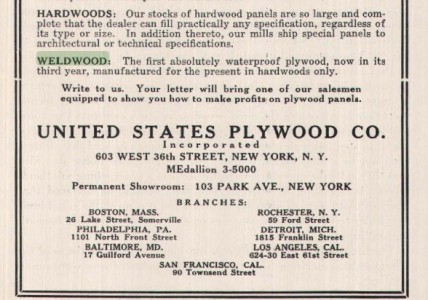
|
Eugene Luther Vidal
Eugene Luther "Gene" Vidal (April 13, 1895 – February 20,
1969) was an American commercial aviation pioneer, New Deal
official and athlete.
He was the father of author Gore Vidal.
For eight years, from 1929 to 1937, he worked closely with Amelia
Earhart in a number of aviation-related enterprises.
...
After leaving the BAC, Vidal experimented from
1937 to 1940 with wood-resin composites using a thermosetting
polymer process similar to Duramold under the banner of the
Vidal Research Corporation.
The experiments with the durable waterproof plywood material,
said to have a greater tensile strength than a comparable
thickness of aluminum, evolved initially into a small business
producing only trays and dinghies.
Vidal patented the process as "Vidal Weldwood",[34] variously
described as "cooked wood" or "molded plywood."
...
After the United States was drawn into World War II, Vidal
obtained contracts to manufacture war materiel, primarily deck
houses for PT boats, pontoons and aircraft drop tanks, that
earned him the wealth that had eluded his earlier
entrepreneurial attempts.
[The variant of the Vidal process used for
watercraft was known as Weldwood Marine]
Restrictions
on the use of metals in 1942, particularly aluminum, caused by
an increased demand by shipbuilders and aircraft manufacturers
led both the Army and the Navy to demand designs for
components and training equipment that could be manufactured
from wood composites.
Investments in factories to build Weldwood products under
license boomed immediately.
One such licensee was the Hughes Aircraft Division of Hughes
Tool Company, and another was U. S. Plywood.[36]
The success of the product was well-publicized and earned him
an honorary doctorate from Lawrence College.[8]
...
After the 1936 elections, (Amelia) Earhart began final
planning for her proposed equatorial circumnavigation of the
world, with fuel and routing across the Pacific Ocean major
considerations.
Vidal suggested that landing strips be built on tiny,
uninhabitable Howland Island as the largest point of land
along the planned route within range of both New Guinea and
Hawaii.
Earhart agreed with the suggestion and made the request for
its use.
...
It is alleged in Susan Butler's biography East to the Dawn:
The Life of Amelia Earhart, and the possibility endorsed by
Kathleen Winters in Amelia Earhart: The Turbulent Life of an
American Icon, that Vidal had a long-standing romantic
relationship with Earhart,[42][43] from 1929 when they worked
together for Transcontinental Air Transport to her
disappearance in 1937.
His son Gore Vidal's cover testimonial to Butler's biography
adds credence to the story.[44][n 17]
wikipedia: Eugene Luther
Vidal
https://en.wikipedia.org/wiki/Eugene_Luther_Vidal
The
Plywood Catalog - 1940
UNITED STATES PLYWOOD CORPORATION
MANUFACTURERS OF PLYWOOD AND ALLIED PRODUCTS
616 WEST 46th STREET • NEW YORK, N. Y. Phone
CIRCLE 6-7100
Page 27
WELDWOOD WELDWOOD is waterproof Plywood.
Its plies are welded together under heat and pressure with a
phenol-formaldehyde binder (Bakelite type).
This binder is not only waterproof but is chemically inert and is
heat resistant up to the charring point of the wood used in the
fabrication of the panel.
Weldwood can be used outdoors for any purpose where lumber is
usually required.
It is suitable for siding, bill boards and other outdoor signs,
farm buildings, truck bodies, trailers, store fronts, paneling for
below-grade basements and boat building.
In every instance in which Weldwood is used, it represents
tremendous economy in labor.
It is much lighter than any of the materials which it replaces and
the finished job is far superior as it eliminates cracks and
reduces joints to a minimum.
WELDWOOD can be obtained from stock in Fir, Birch, Mahogany and
Walnut.
On special order, it can be obtained in practically any other
wood.
...
EXTRA SELECTED MARINE
Specially fabricated for Boat-building Industry
Boatbuilders and others requiring WELDWOOD for extra hard
service may now specify "Marine WELDWOOD" for their jobs.
The bond used in Marine WELDWOOD is identical with that used in
standard WELDWOOD but this product is made with tight cores
and "no patch" faces.
The introduction of this special grade
marks the final step in the perfection of WELDWOOD.
The plywood catalog - 1940
https://archive.org/details/ThePlywoodCatalog-1940
Weldwood does not
appear in The plywood catalog - 1938
https://archive.org/details/ThePlywoodCatalog-1938
A digression: for a very 1950s illustrated
presentation, see The Story of
Plywood by American Plywood Association, 1954
https://archive.org/details/TheStoryOfPlywood
An advertisement for Weldwood appeared in Australia in 1944 and
two sheets of Waterproof Ply (14ft x 2ft x
1/4'') were specified in plans for a Blake-type hollow board prepared for the Surf
Life Saving Association of Australia in 1945.
However, marine plywood was
probably available in Australia well before this time.
1944 'Advertising', The Argus
(Melbourne, Vic. : 1848 - 1957), 15 April, p. 5. , viewed 06
Aug 2016,
http://nla.gov.au/nla.news-article11813934
It
appears Vidal's Weldwood was not the only marine ply
produced in the 1930s, the Harbor Plywood Corporation produced a product
known as (Super) Harbord following the work
of James Nevin in 1934:
A Technological
Breakthrough: Waterproof Adhesive
Lack of a waterproof adhesive that would make
plywood suitable for exterior exposure eventually led automobile
manufacturers to switch from plywood to more durable metal running
boards.
A breakthrough came in 1934 when Dr. James Nevin, a chemist at
Harbor Plywood Corporation in Aberdeen, Washington, finally
developed a fully waterproof adhesive.
This technology advancement had the potential to open up
significant new markets.
But the industry remained fragmented.
Product quality and grading systems varied widely from mill to
mill.
Individual companies didn’t have the technical or in most cases
marketing resources to research, develop and promote new uses for
plywood.
The industry looked for help from its newly formed trade
association, the Douglas Fir Plywood
https://www.apawood.org/apas-history
Also
Thomas C. Jester (editor): Twentieth-Century Building
Materials: History and Conservation, 2014, page 102.
https://books.google.com.au/books?isbn=1606063251
2. CANOES
Dating back to
antiquity, the dugout, bark or skin canoe was the
basic vessel of aboriginal peoples around the
world
However, as a recreational craft the canoe
captured the imagination of Europe following the
publication of John MacGregor’s best-selling A Thousand
Miles in the Rob Roy Canoe in 1866.
A clinker oak hull with a
cedar deck, the original Rob Roy canoe, built in 1865 by
Thames boatbuilders Searle & Sons of Lambeth for
John MacGregor’s tour of Europe, is now preserved at the
River and Rowing Museum, Mill Meadows, Henley on Thames,
Oxfordshire.
|
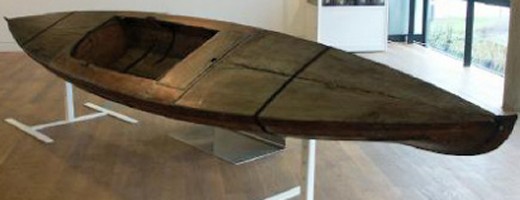
|
Around the turn of the 20th
century canoe builders used standard plywood laminated between
layers of painted canvas to produce a lighter craft, before the
introduction of relatively inexpensive marine grade plywood in
the late 1930s.
After the WW2, recreational plywood canoes were ubiquitous on
the lakes, rivers and bays of Australia, often available from
boat-hire services at resorts, before they were progressively replaced by
fibreglass canoes during the 1970s.
With the coming of the 21st century, plastic molded canoes
dominate the recreational market.
Frank
and Betty Cater and plywood canoe, Patonga NSW, 1950.
3. SURF-SKIS
http://www.surfresearch.com.au/0000h_SurfSki.html
4. TOM BLAKE - AMELIA EARHART - HAWAII - 1935
In 1935 Amelia Earhart wrote an article My
Flight from Hawaii, published in National Geographic,
May 1935.
The magazine also contained eight surfing
photographs at
Waikiki by Tom Blake, including one of
Amelia riding in an outrigger canoe.
© Thomas Edward Blake
AMELIA
EARHART, WHILE AWAITING FAVORABLE FLIGHT WEATHER,
ENJOYED RIDES IN SUCH OUTRIGGER CANOES AT WAIKIKI
Easier to handle than the
tricky board, the canoes offer good fun.
When the surf is not too big, gay parties,
sometimes as many as seven in a boat, may be seen riding the
waves in these queer craft, which are hollowed koa logs, with
side floats to prevent capsizing.
At the steersman's signal all paddle furiously
till the swell lifts them and bears them fast toward shore.
Lashed together anil provided with woven grass
sails, such vessels have been used by natives for long ocean
voyages.

surfresearch.com.au
REFERENCES
FOR
THIS SECTION
books
1949 Maxwell, C. Bede
Surf : Australians Against the Sea
Angus and Robertson Sydney
1959 Bloomfield,
John Know-how in the Surf
Angus and Robertson 89 Castlereagh
Street, Sydney
1961 Harris, Reg. S.The
History of Manly Life Saving Club 1911-1961
Published by Manly Life Saving Club,
NSW Printed by Publicity Press Ltd.
1964 Severson, John: Surfing
Around the World
Doubleday and Company, Inc,
Garden City New York.
1965 Farrelly, Midget. As
told to McGregor, Craig : This Surfing Life
Rigby Limited, James Place,
Adelaide
1966 Finney, Ben and
Houston, James D. : Surfing – A History of the Ancient
Hawaiian Sport
Pomegranate Books P.O. Box 6099
Rohnert Park, CA 94927 Reprint 1996
1968 Kahanamoku, Duke With
Brennan, Joe: Duke Kahanamoku’s World of Surfing
Angus and Robertson Publishers Sydney
, Australia 1972 2nd Edition A&R Paperbacks, Sydney ,
Australia
1968
Pollard, Jack (ed.) : Ampol’s Sporting Records
Jack Pollard
Pty. Ltd., 42 Pacific Highway, North Sydney NSW 2060
Reprinted 1969,
1971, 1973
1970 Margan, Frank and
Finney, Ben R. : A Pictorial History of Surfing
Paul Hamlyn Pty Ltd, 176 South Creek
Road, Dee Why West, NSW 2099.
1964 Pollard, Jack
(ed.): The Australian Surfrider
K.G.Murray Publishing Co.P/L,142
Clarence Street , Sydney Australia
1972 The Best of
Tracks (Vol. I) Editors : Falzon, Albert;
Stewart, John; Grissim, John. :
Tracks Publishing Co Pty Ltd. P.O.
Box 178 Avalon, NSW.
'Bob McTavish’s Personal History of
Surfboard Design – Pods for Primates Parts 1' (pages 120 – 122).
1992 Stell, Marion K.
: Pam Burridge
Collins Angus & Robertson
Publishers (Australia) Pty. Limited
A division of Harper Collins
Publishers (Australia) Pty. Limited
25 Ryde Road, Pymble NSW 2073,
Australia
1979 Pearson, Kent : Surfing
Subcultures
of Australia and New Zealand
University of Queensland
Press, St. Lucia, Queensland
1997 Warshaw, Matt : Surfriders
–
In Search of the Perfect Wave
Tehabi Books, Inc. Collins
Publishers, 10 East 53rd Street, New York, NY 10022
1978 Warwick, Wayne A
Guide to Surfriding in New Zealand Second Edition
Viking Sevenseas Ltd Wellington, New
Zealand
1979 Young, Nat ;
Photographs by McCausland, Bill: Nat Young’s Book of Surfing
A.H. & A.W. Reed Pty. Ltd. 53
Myroora Rd, Terry Hills, Sydney.
1983 Young, Nat with
McGregor, Craig : The History 0f Surfing
Palm Beach Press,40 Palm Beach Road,
Palm Beach NSW 2108
1997 Kampion, Drew: Stoked
: A History of Surf Culture
General Publishing Group Los
Angles
1998 Second edition by Benedikt
Tashen Verlag GmbH, Hohenzollernring 53, D-50672 Koin.
1991 Carroll, Nick (editor):
The Next Wave : A Survey of World Surfing
Collins Angus & Robertson
Publishers Pty Ltd 4 Eden Park, 31 Waterloo Road, North Ryde NSW
2113
web sites
Malcom Gault-Williams: LEGENDARY SURFERS
Tom Blake's Hawaiian
Visits 1925 to 1950.
Notes by Judy Blake, 2007.
Posted by email from Gary Lynch in
March 2007, with the note:
"FYI. Very interesting details
recently unearthed by Judy Blake."
Hi Gary,
I've been meaning to get back
to you on some info (interesting but not earth shattering) I
discovered on Frances E. Cunningham Blake. She was born in
Bartlesville, Oklahoma on July 8, 1907 and was 1/8 American
Indian. Frances must have been very young when she married
Tom. She and Tom were passengers on the Calawai which
departed from Honolulu, Hawaii and arrived in San Pedro,
California on Dec. 12, 1925. Frances was 18 and Tom was 23
at the time.
Frances' parents, Alfred and
Laura Cunningham were each 1/16 American Indian. Her older
brother, Edward was 14 years her senior. I don't know what
happened to her dad, but Frances and her mom were living
with the Lombard family in Los Angeles in 1920 and
Edward was still on the ranch in Oklahoma. Robert Lombard
was her mom's brother. Frances was 12 years old when the
1920 census was taken.
I cannot find Frances
(Cunningham or Blake) on the 1930 U.S. census. Either her
name was misspelled, she was not counted, or she had died or
remarried when the 1930 census was taken.
I have records of a few other
return trips Tom had made from Hawaii but Frances was never
on the passenger list.
Tom was on the list of
the Calawai when it arrived in Wilmington, Ca. on Nov. 1,
1930.
He was aboard the ship,
City of Los Angeles on Oct. 2, 1931 on it's arrival in
Wilmington.
On June 18, 1932, he traveled
on the Calawai from Honolulu to Los Angeles.
Tom arrived in Los Angeles
aboard the Lurline on March 6, 1937.
The next record I have of his
arrival from Hawaii was on July 16, 1941 on the ship,
Matsonia. He just missed the bombing of Pearl Harbor.
The final passenger list I
found with Tom's name was from the Lurline on April
17, 1950.
Right after my last email in
November, my mom was diagnosed with terminal cancer. She
died on Dec. 18. My dad is still having a difficult time
coping with the loss. They would have been married 65 years
next month.
Judy Blake

surfresearch.com.au
Geoff Cater (2000-2015) : Tom Blake and the
Paddle-board, 1935
http://www.surfresearch.com.au/1935_Blake.htm


















